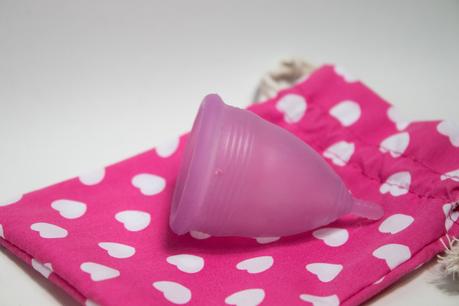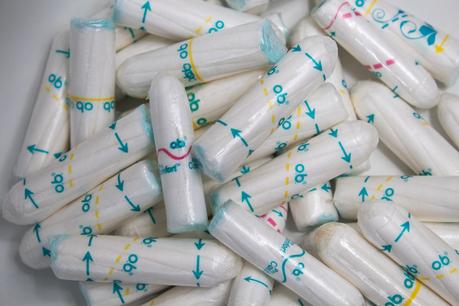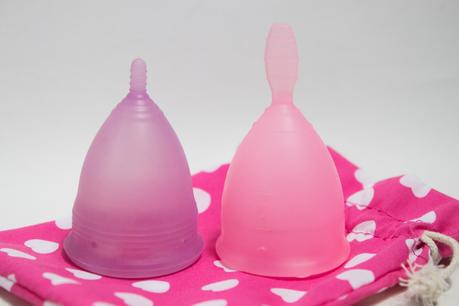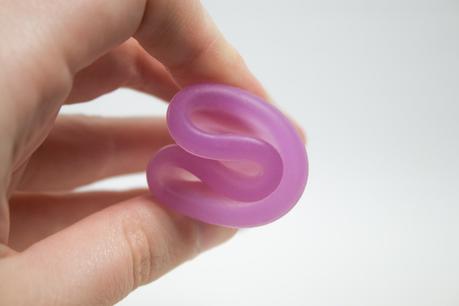Heute geht es zum Green Saturday mal unter die Gürtellinie, aber nicht auf eine schlechte Art und Weise. Für Männer mag der heutige Post vielleicht nichts sein, aber vielleicht will der ein oder andere ja auch seine Partnerin bereichern. Denn heute soll es um Menstruationstassen gehen und zwar darum was das ist, wofür sie gut ist und dann natürlich noch die Frage: Was hat das jetzt mit Umweltschutz zu tun?
Was ist eine Menstruationstasse?
Vielleicht hat der ein oder andere schonmal davon gehört, aber ich möchte dennoch kurz erklären, worum es sich handelt. Eine Menstruationstasse ist ein kleiner Kelch aus medizinischem Silikon der als Ersatz für Tampons und Binden während der Periode benutzt werden kann. Das Cup ist wiederverwendbar und das sogar mehrere Jahre. Wer mehr über die Funktionsweise und wie man die Tasse benutzt lesen will, kann gern mal bei meiner Blogger Kollegin Justine vorbeischauen, die hier einen sehr ausführlichen Artikel zum Thema geschrieben hat. Bei mir geht es jetzt mit den Vorteilen der Tasse weiter.
Today's Green Saturday is going below the belt, but not in a bad kind. For men, this post might be pretty boring, but maybe some of you also want to enrich your girlfriends. Today's blogpost is all about menstrual cups: What they are, what they are good for and of course the question: What is the connection to our environment?
What is a Menstrual Cup?
Maybe some of you already heard about them, but I still want to tell you, what menstrual cups are. It's a little goblet out of medical silicon, which can be used as a replacement for tampons and sanitary pads. The cups are reusable for several years.

Warum eine Menstruationstasse benutzen?
Malen wir uns erstmal aus, wie viele Tampons eine Frau eigentlich benutzt: eine Frau hat 12 mal im Jahr ihre Periode, diese dauert jeweils ca. 5 Tage. Rechnen wir damit, dass eine Frau 3 Tampons pro Tag verwendet, dann sind das 180 Tampons pro Jahr. Nun möchte ich das noch auf das Leben einer Frau erhöhen, nehmen wir an, dass sie ca. mit 12 Jahren ihre Periode bekommt und sie mit ca. 50 Jahren aufhört, dann sind das 38 Jahre. Diese Zahl nehmen wir nun mal 180 Tampons pro Jahr, das ergibt dann 6840 Tampons. Dazu muss ich natürlich noch sagen, dass das keine statistisch festgelegten Durchschnittswerte sind - diese sind nämlich gar nicht so leicht zu finden - sondern einfach Zahlen, die ich für logisch halte. Im Web habe ich noch weit größere Zahlen gefunden. Im Grunde kann das aber auch jede Frau für sich selbst berechnen, mit eigenen Durchschnittswerten.
Aber nun verschiedene Gründe, warum Menstruationstassen sinnvoll sind:
Why using a menstrual cup?
Let's think about how many tampons a woman is actually using. A woman has her period 12 times a year, for about 5 days. If we assume that she is using 3 tampons a day, that's 180 tampons every year. Now let's calculate how many tampons she uses in her whole life: Her period might start when she is about 12 years old and ends at the age of 50, that's 38 years. Now multiply this with 180 tampons a year, that's 6840. Well, I have to tell you, that this isn't statistical facts - those are pretty hard to find -, it's just numbers I deem to be logical. On some pages I found through google, I read bigger numbers, like 16000. Theoretically, every woman can calculate her own average value.
But now I want to talk about, why menstrual cups are great:


1. Für die Umwelt: Jedes Jahr werden in Deutschland 1 Milliarden Tampons gekauft, alle sind sie Wegwerfprodukte, die nur einmalig genutzt werden. Dabei ist jeder einzelne Tampon in Plastik verpackt, in einigen Ländern ist an jedem Tampon noch ein Applikator aus Plastik angebracht, damit sich Frau nicht selbst anfassen muss. Und auch der Tampon selbst besteht nicht nur aus natürlichen Stoffen. Besonders schlimm sind allerdings konventionelle Binden, welche Kunststoff, Latex, Acrylbindemittel und Klebstoff enthalten. Wenn eine Frau nun in ihrem Leben fast 7000 Tampons benutzt und wegschmeißt, brauche ich wohl gar nichts mehr dazu sagen, was für ein Müllberg das ist!
Menstruationstassen sind wiederverwendbar und das Jahre lang, somit verursacht man viel weniger Müll. Tauscht man die Tasse alle 2 Jahre aus, wären das nur 19 Menstruationstassen pro Frau, wodurch der anfallende Müll relativ gering gehalten wird.
Außerdem sind Menstruationstassen ressourcenschonend und man braucht keinerlei chemische Reinigungsmittel um sie zu säubern, ein bisschen Wasser und ab und zu mal abkochen reicht vollkommen aus.
1. For the environment: Every year 1 billion tampons are sold in Germany, every one of them is thrown away and only used one time. Every one of them is wrapped in plastic and in some countries every one of them even has an applicator out of plastic, so the woman doesn't have to touch herself. Also, the tampon itself isn't only out of natural resources. But sanitary pads are even worse, they contain synthetic material, latex, acrylic binder and glue. Now every woman is using about 7000 Tampons - like we calculated before - and throwing them away. I think, I don't have to tell you how much waste this is, do I?
Menstrual cups are reusable over years, so you don't produce so much waste. If you replace your cup every two years, that's only 19 cups per women in her whole life! So the waste is minimized.
Besides menstrual cups are resource-efficient and you don't need any chemical cleansers - you can just wash it with water and sometimes boil it.

2. Für den Geldbeutel: Die Tasse ist allerdings nicht nur umweltfreundlich sondern auch gut fürs Portmonee, eine Tasse kostet nämlich 10 bis 15€ und hält wie schon erwähnt mehrere Jahre. Nun habe ich eine kleine Rechnung aufgestellt: eine Packung "Tampons Original Normal" von o.b. mit 32 Stück kostet 2,75€, das sind 0,09€ pro Tampon. Bei 180 Tampons pro Jahr sind das schon 16,20€. Somit lohnt sich die Menstruationstasse schon nach weniger als einem Jahr der Verwendung. Zumal ich gerade wieder nur Durchschnittswerte verwendet habe, die ich selbst für realistisch halte, es gibt sicher Leute, die mehr oder auch teurere Tampons benutzen.
3. Für die Hygiene: Menstruationstassen bestehen aus medizinischem Silikon, also jenes Silikon, dass auch in den Körper implantiert wird. Tampons dagegen sind sehr anfällig für Bakterien - weshalb man sie ja auch so oft wechseln muss. Außerdem können Tampons Toxische Schocks hervorrufen. Diese werden durch ein bestimmtes Bakterium ausgelöst, gerät es in eine offene Wunde oder Schleimhaut, so bildet sich ein Gift, welches im schlimmsten Falle sogar tödlich sein kann. Menstruationstassen hingegen sind nicht anfällig für Bakterien.
Allerdings sollte man auch bei dem Kauf einer Menstruationstasse immer auf die Inhaltsstoffe achten! Empfehlenswert sind jene aus reinem, medizinischem Silikon.
Darüberhinaus trocknen Tampons die Schleimhäute aus, bei Menstruationstassen ist das kein Problem mehr.
2. For your wallet: The cup isn't only environmentally friendly, it's also good for your wallet. One cup costs 10 to 15€ and like I already said it lasts several years. Now I made another little reckoning: in Germany, one package of normal tampons by the brand o.b. with 32 tampons costs 2,75€, that's 0,09€ per tampon. With 180 tampons a year that's 16,20€. So a menstrual cup pays off after less than one year. Especially because I only used average values and some people might buy more expensive tampons.
3. For hygienics: menstrual cups are normally made off medical silicon, which is the same silicon sometimes implanted into human bodies. However, tampons are really susceptible to germs - what's also why you have to change them so often. Moreover, tampons can cause toxic shocks, which are triggered by a certain germ. So it's causing a poison, which in the worst case can be deadly. Menstrual cups aren't susceptible to germs at all.
By the way please watch out for the ingredients of your menstrual cup, I can only recommend those out of clinical silicon - and only out of that!
By the way, tampons also drain your mucosa, which isn't a problem anymore with the cup.


4. Für weniger Stress: Kennst du den Moment, wenn du gerade mal wieder deine Periode bekommen hast und merkst, dass schon wieder eine Tampons im Haus sind? Mit Verwendung einer Menstruationstasse wird dir das nie wieder passieren, denn sie muss nicht ständig neu gekauft werden.
Ein weiterer Punkt, der einem eine Menge Stress nimmt, ist die Tatsache, dass man Menstruationstassen nicht halb so oft wechseln muss wie Tampons. Empfohlen wird, sie maximal 12h zu tragen, aber das ist doch recht lange oder?
Abschließend kann ich dir also nur empfehlen, dir so bald wie möglich eine Menstruationstasse zuzulegen! Ich habe bisher keinen einzigen Nachteil gefunden und bin selbst sehr zufrieden mit meinem Cup. Falls dich meine Argumente überzeugt haben, kann ich dir folgende Tasse empfehlen, die ich selbst nutze: Dutchess Menstruationstasse . Achte allerdings unbedingt auf die Größe, für Frauen die noch kein Kind geboren haben wird die kleinere Größe B empfohlen.
. Achte allerdings unbedingt auf die Größe, für Frauen die noch kein Kind geboren haben wird die kleinere Größe B empfohlen.
4. For less stress: Do you know this moment, when you just got your period and then you notice, there is no tampon left in the house? When you use a menstrual cup from now on, you won't have this problem anymore, because you don't have to buy a new one so often.
Another point is, that you don't have to change the cup very often. It's recommended to use them 12h maximum, but that's pretty long, isn't it?
To sum up, I can really recommend you to start using a menstrual cup! I'm really happy with mine and I couldn't find any contra by now. For the case that my arguments convinced you, I also want to tell you which cup I'm using: the Dutchess menstrual cup . But please watch out for the size, size B is recommended for women that didn't give birth to a child by now.
. But please watch out for the size, size B is recommended for women that didn't give birth to a child by now.
Was ist eine Menstruationstasse?
Vielleicht hat der ein oder andere schonmal davon gehört, aber ich möchte dennoch kurz erklären, worum es sich handelt. Eine Menstruationstasse ist ein kleiner Kelch aus medizinischem Silikon der als Ersatz für Tampons und Binden während der Periode benutzt werden kann. Das Cup ist wiederverwendbar und das sogar mehrere Jahre. Wer mehr über die Funktionsweise und wie man die Tasse benutzt lesen will, kann gern mal bei meiner Blogger Kollegin Justine vorbeischauen, die hier einen sehr ausführlichen Artikel zum Thema geschrieben hat. Bei mir geht es jetzt mit den Vorteilen der Tasse weiter.
Today's Green Saturday is going below the belt, but not in a bad kind. For men, this post might be pretty boring, but maybe some of you also want to enrich your girlfriends. Today's blogpost is all about menstrual cups: What they are, what they are good for and of course the question: What is the connection to our environment?
What is a Menstrual Cup?
Maybe some of you already heard about them, but I still want to tell you, what menstrual cups are. It's a little goblet out of medical silicon, which can be used as a replacement for tampons and sanitary pads. The cups are reusable for several years.

Warum eine Menstruationstasse benutzen?
Malen wir uns erstmal aus, wie viele Tampons eine Frau eigentlich benutzt: eine Frau hat 12 mal im Jahr ihre Periode, diese dauert jeweils ca. 5 Tage. Rechnen wir damit, dass eine Frau 3 Tampons pro Tag verwendet, dann sind das 180 Tampons pro Jahr. Nun möchte ich das noch auf das Leben einer Frau erhöhen, nehmen wir an, dass sie ca. mit 12 Jahren ihre Periode bekommt und sie mit ca. 50 Jahren aufhört, dann sind das 38 Jahre. Diese Zahl nehmen wir nun mal 180 Tampons pro Jahr, das ergibt dann 6840 Tampons. Dazu muss ich natürlich noch sagen, dass das keine statistisch festgelegten Durchschnittswerte sind - diese sind nämlich gar nicht so leicht zu finden - sondern einfach Zahlen, die ich für logisch halte. Im Web habe ich noch weit größere Zahlen gefunden. Im Grunde kann das aber auch jede Frau für sich selbst berechnen, mit eigenen Durchschnittswerten.
Aber nun verschiedene Gründe, warum Menstruationstassen sinnvoll sind:
Why using a menstrual cup?
Let's think about how many tampons a woman is actually using. A woman has her period 12 times a year, for about 5 days. If we assume that she is using 3 tampons a day, that's 180 tampons every year. Now let's calculate how many tampons she uses in her whole life: Her period might start when she is about 12 years old and ends at the age of 50, that's 38 years. Now multiply this with 180 tampons a year, that's 6840. Well, I have to tell you, that this isn't statistical facts - those are pretty hard to find -, it's just numbers I deem to be logical. On some pages I found through google, I read bigger numbers, like 16000. Theoretically, every woman can calculate her own average value.
But now I want to talk about, why menstrual cups are great:


1. Für die Umwelt: Jedes Jahr werden in Deutschland 1 Milliarden Tampons gekauft, alle sind sie Wegwerfprodukte, die nur einmalig genutzt werden. Dabei ist jeder einzelne Tampon in Plastik verpackt, in einigen Ländern ist an jedem Tampon noch ein Applikator aus Plastik angebracht, damit sich Frau nicht selbst anfassen muss. Und auch der Tampon selbst besteht nicht nur aus natürlichen Stoffen. Besonders schlimm sind allerdings konventionelle Binden, welche Kunststoff, Latex, Acrylbindemittel und Klebstoff enthalten. Wenn eine Frau nun in ihrem Leben fast 7000 Tampons benutzt und wegschmeißt, brauche ich wohl gar nichts mehr dazu sagen, was für ein Müllberg das ist!
Menstruationstassen sind wiederverwendbar und das Jahre lang, somit verursacht man viel weniger Müll. Tauscht man die Tasse alle 2 Jahre aus, wären das nur 19 Menstruationstassen pro Frau, wodurch der anfallende Müll relativ gering gehalten wird.
Außerdem sind Menstruationstassen ressourcenschonend und man braucht keinerlei chemische Reinigungsmittel um sie zu säubern, ein bisschen Wasser und ab und zu mal abkochen reicht vollkommen aus.
1. For the environment: Every year 1 billion tampons are sold in Germany, every one of them is thrown away and only used one time. Every one of them is wrapped in plastic and in some countries every one of them even has an applicator out of plastic, so the woman doesn't have to touch herself. Also, the tampon itself isn't only out of natural resources. But sanitary pads are even worse, they contain synthetic material, latex, acrylic binder and glue. Now every woman is using about 7000 Tampons - like we calculated before - and throwing them away. I think, I don't have to tell you how much waste this is, do I?
Menstrual cups are reusable over years, so you don't produce so much waste. If you replace your cup every two years, that's only 19 cups per women in her whole life! So the waste is minimized.
Besides menstrual cups are resource-efficient and you don't need any chemical cleansers - you can just wash it with water and sometimes boil it.

2. Für den Geldbeutel: Die Tasse ist allerdings nicht nur umweltfreundlich sondern auch gut fürs Portmonee, eine Tasse kostet nämlich 10 bis 15€ und hält wie schon erwähnt mehrere Jahre. Nun habe ich eine kleine Rechnung aufgestellt: eine Packung "Tampons Original Normal" von o.b. mit 32 Stück kostet 2,75€, das sind 0,09€ pro Tampon. Bei 180 Tampons pro Jahr sind das schon 16,20€. Somit lohnt sich die Menstruationstasse schon nach weniger als einem Jahr der Verwendung. Zumal ich gerade wieder nur Durchschnittswerte verwendet habe, die ich selbst für realistisch halte, es gibt sicher Leute, die mehr oder auch teurere Tampons benutzen.
3. Für die Hygiene: Menstruationstassen bestehen aus medizinischem Silikon, also jenes Silikon, dass auch in den Körper implantiert wird. Tampons dagegen sind sehr anfällig für Bakterien - weshalb man sie ja auch so oft wechseln muss. Außerdem können Tampons Toxische Schocks hervorrufen. Diese werden durch ein bestimmtes Bakterium ausgelöst, gerät es in eine offene Wunde oder Schleimhaut, so bildet sich ein Gift, welches im schlimmsten Falle sogar tödlich sein kann. Menstruationstassen hingegen sind nicht anfällig für Bakterien.
Allerdings sollte man auch bei dem Kauf einer Menstruationstasse immer auf die Inhaltsstoffe achten! Empfehlenswert sind jene aus reinem, medizinischem Silikon.
Darüberhinaus trocknen Tampons die Schleimhäute aus, bei Menstruationstassen ist das kein Problem mehr.
2. For your wallet: The cup isn't only environmentally friendly, it's also good for your wallet. One cup costs 10 to 15€ and like I already said it lasts several years. Now I made another little reckoning: in Germany, one package of normal tampons by the brand o.b. with 32 tampons costs 2,75€, that's 0,09€ per tampon. With 180 tampons a year that's 16,20€. So a menstrual cup pays off after less than one year. Especially because I only used average values and some people might buy more expensive tampons.
3. For hygienics: menstrual cups are normally made off medical silicon, which is the same silicon sometimes implanted into human bodies. However, tampons are really susceptible to germs - what's also why you have to change them so often. Moreover, tampons can cause toxic shocks, which are triggered by a certain germ. So it's causing a poison, which in the worst case can be deadly. Menstrual cups aren't susceptible to germs at all.
By the way please watch out for the ingredients of your menstrual cup, I can only recommend those out of clinical silicon - and only out of that!
By the way, tampons also drain your mucosa, which isn't a problem anymore with the cup.


4. Für weniger Stress: Kennst du den Moment, wenn du gerade mal wieder deine Periode bekommen hast und merkst, dass schon wieder eine Tampons im Haus sind? Mit Verwendung einer Menstruationstasse wird dir das nie wieder passieren, denn sie muss nicht ständig neu gekauft werden.
Ein weiterer Punkt, der einem eine Menge Stress nimmt, ist die Tatsache, dass man Menstruationstassen nicht halb so oft wechseln muss wie Tampons. Empfohlen wird, sie maximal 12h zu tragen, aber das ist doch recht lange oder?
Abschließend kann ich dir also nur empfehlen, dir so bald wie möglich eine Menstruationstasse zuzulegen! Ich habe bisher keinen einzigen Nachteil gefunden und bin selbst sehr zufrieden mit meinem Cup. Falls dich meine Argumente überzeugt haben, kann ich dir folgende Tasse empfehlen, die ich selbst nutze: Dutchess Menstruationstasse
4. For less stress: Do you know this moment, when you just got your period and then you notice, there is no tampon left in the house? When you use a menstrual cup from now on, you won't have this problem anymore, because you don't have to buy a new one so often.
Another point is, that you don't have to change the cup very often. It's recommended to use them 12h maximum, but that's pretty long, isn't it?
To sum up, I can really recommend you to start using a menstrual cup! I'm really happy with mine and I couldn't find any contra by now. For the case that my arguments convinced you, I also want to tell you which cup I'm using: the Dutchess menstrual cup

